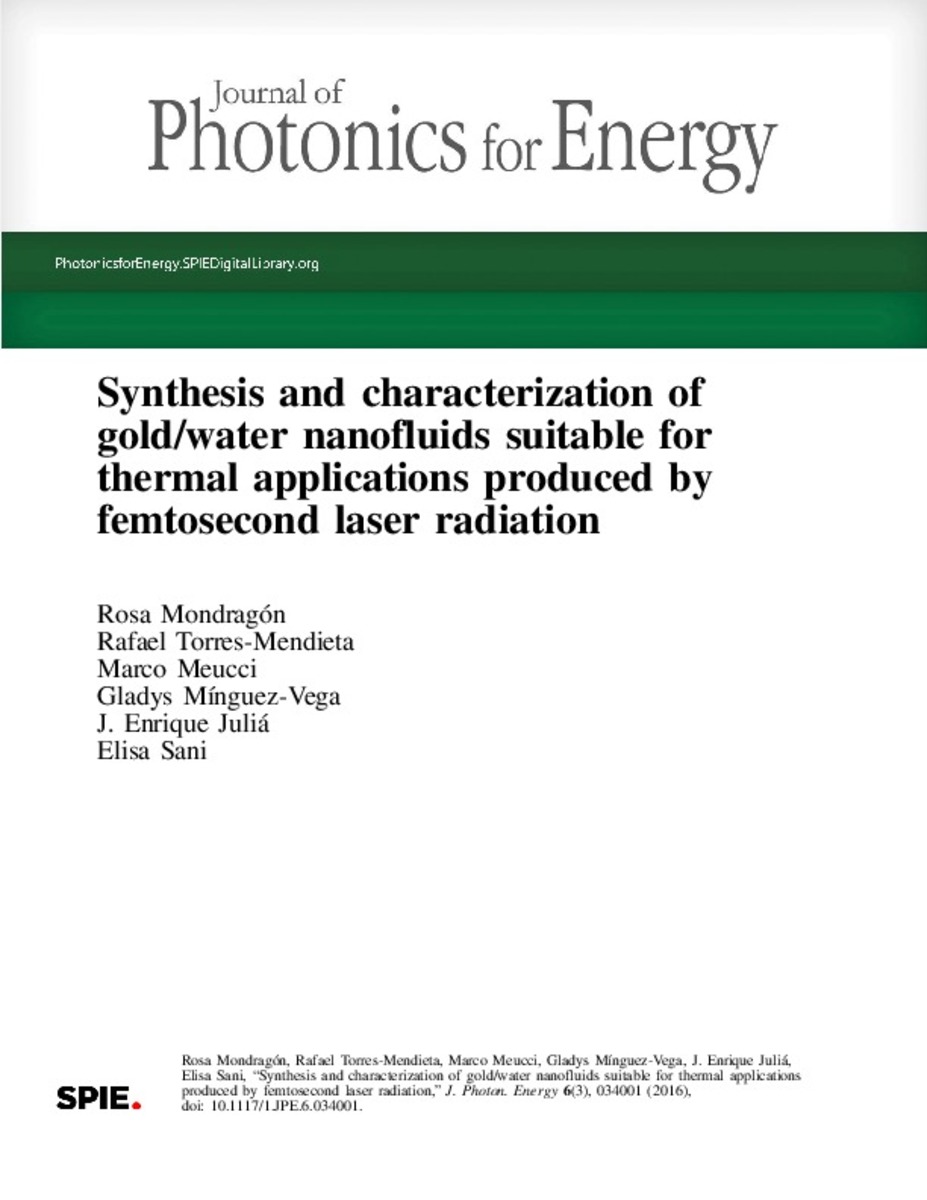Mostrar el registro sencillo del ítem
Synthesis and characterization of gold/water nanofluids suitable for thermal applications produced by femtosecond laser radiation
| dc.contributor.author | Mondragon, Rosa | |
| dc.contributor.author | Torres-Mendieta, Rafael | |
| dc.contributor.author | Meucci, Marco | |
| dc.contributor.author | Mínguez-Vega, Gladys | |
| dc.contributor.author | Juliá Bolívar, José Enrique | |
| dc.contributor.author | Sani, Elisa | |
| dc.date.accessioned | 2016-07-22T09:41:43Z | |
| dc.date.available | 2016-07-22T09:41:43Z | |
| dc.date.issued | 2016-07 | |
| dc.identifier.issn | 1947-7988 | |
| dc.identifier.uri | http://hdl.handle.net/10234/161868 | |
| dc.description.abstract | A laser-based “green” synthesis of nanoparticles (NPs) was used to manufacture gold NPs in water. The light source is a Ti:Sapphire laser with 30 fs FWHM pulses, 800 nm mean wavelength, and 1 kHz repetition rate. The method involves two stages: (1) pulsed laser ablation in liquids and (2) photo-fragmentation (PF). Highly pure and well-dispersed NPs with a diameter of 18.5 nm that can be stored at room temperature without showing any agglomeration over a period of at least 3 months were produced without the need to use any stabilizer. Transmittance spectra, extinction coefficient, NPs agglomeration dynamics, and thermal conductivity of the nanofluids obtained were analyzed before and after being submitted to thermal cycling and compared to those obtained for commercial gold/water suspensions. Optical properties have also been investigated, showing no substantial differences for thermal applications between NPs produced by the laser ablation and PF technique and commercial NPs. Therefore, nanofluids produced by this technique can be used in thermal applications, which are foreseen for conventional nanofluids, e.g., heat transfer enhancement and solar radiation direct absorption, but offering the opportunity to produce them in situ in almost any kind of fluid without the production of any chemical waste. | ca_CA |
| dc.description.sponsorShip | This work was partially funded by the Generalitat Valenciana through the programme PROMETEO–2012–021, and by the Universitat Jaume I through the projects P1·1B2013–43 and P1·1B2013–53. Financial support from the Spanish Ministry of Science FIS2013– 40666–P is also acknowledged. The authors are also very grateful to the Servicios Centrales de Instrumentación Científica (SCIC) of the Universitat Jaume I for the use of the femtosecond laser. R. Torres-Mendieta gratefully acknowledges the Generalitat Valenciana support from the Santiago Grisolia scholarship GRISOLIA/2013/015. The Italian bank foundation “Fondazione Ente Cassa di Risparmio di Firenze” is gratefully acknowledged for providing the grant for M. Meucci within the framework of the “SOLE” and “SOLE-2” projects (pratiche n. 2013.0726 and 2014.0711). Thanks are due to Mr. Mauro Pucci and Mr. Massimo D’Uva from CNR-INO for technical assistance. | ca_CA |
| dc.format.extent | 13 p. | ca_CA |
| dc.format.mimetype | application/pdf | ca_CA |
| dc.language.iso | eng | ca_CA |
| dc.publisher | Society of Photo-optical Instrumentation Engineers (SPIE) | ca_CA |
| dc.relation.isPartOf | Journal of Photonics for Energy, 2016, V. 6, n. 3 | ca_CA |
| dc.rights | © 2016 Society of Photo-Optical Instrumentation Engineers (SPIE) | ca_CA |
| dc.rights.uri | http://rightsstatements.org/vocab/InC/1.0/ | * |
| dc.subject | nanofluid | ca_CA |
| dc.subject | femtosecond laser | ca_CA |
| dc.subject | solar radiation | ca_CA |
| dc.subject | volumetric solar receiver | ca_CA |
| dc.title | Synthesis and characterization of gold/water nanofluids suitable for thermal applications produced by femtosecond laser radiation | ca_CA |
| dc.type | info:eu-repo/semantics/article | ca_CA |
| dc.identifier.doi | http://dx.doi.org/10.1117/1.JPE.6.034001 | |
| dc.rights.accessRights | info:eu-repo/semantics/openAccess | ca_CA |
| dc.relation.publisherVersion | http://spie.org/publications/journals/journal-of-photonics-for-energy | ca_CA |
Ficheros en el ítem
Este ítem aparece en la(s) siguiente(s) colección(ones)
-
EMC_Articles [803]







